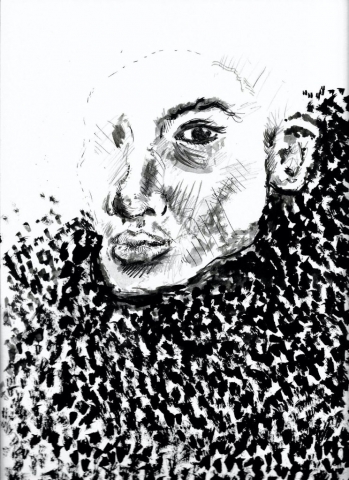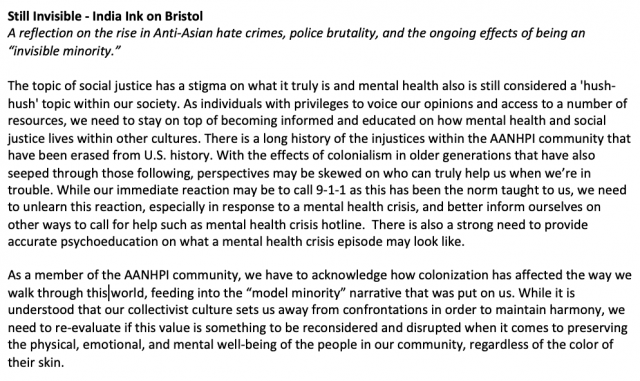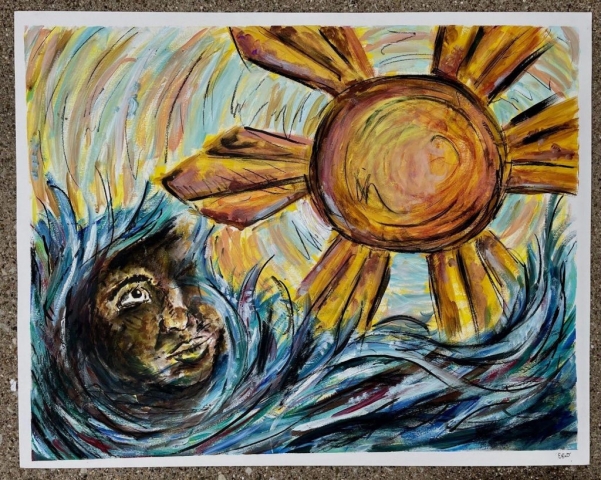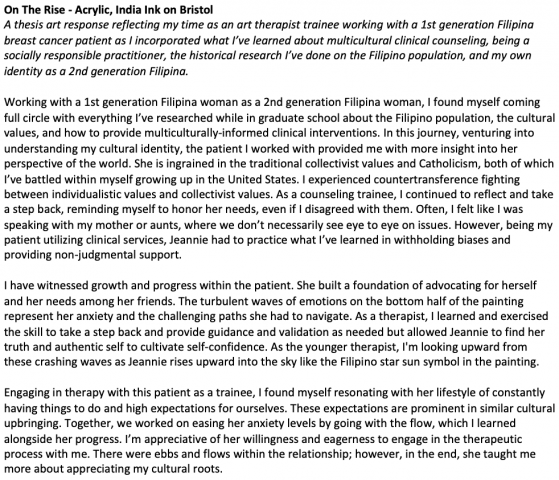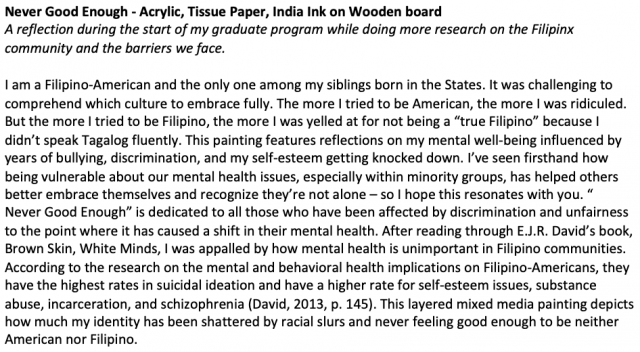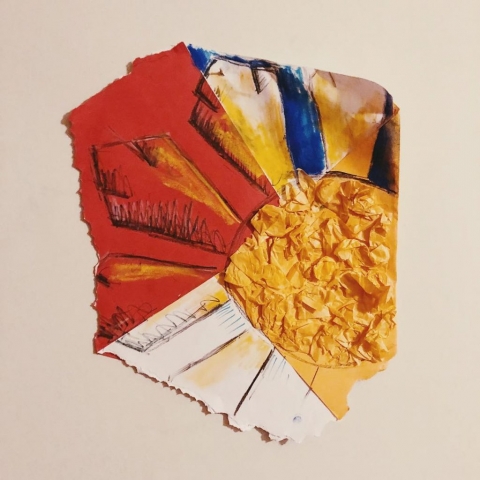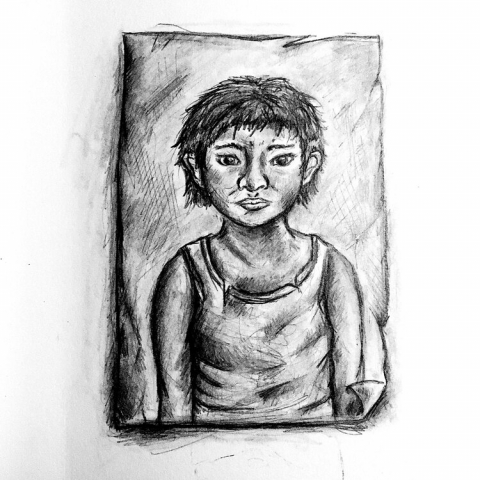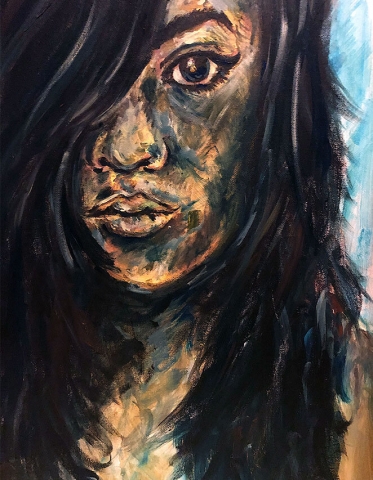Elisha-Rio P. Apilado
Artwork Title: On the Rise
Year: 2021
Medium: Acrylic, India Ink on Bristol
Artist Statement
I’ve pushed myself to remain open-minded, curious, and continue to question everything I read, hear, or see because I want to gain a broader range of perspectives and worldviews. This allows me to take into account that not everything I read in school is necessarily the correct information. As an art therapist and counselor, this is a reminder to myself how important it is to understand the patient/client’s perspective and see the world from their lens to better inform how we treat them.
Click on artwork to read more about it.
ABOUT THE ARTIST
Before switching her career path from advertising to psychotherapy, Elisha-Rio P. Apilado worked for ten years in marketing as an art director, graphic designer, and illustrator. After a couple of years working as an art teacher at homeless shelters and leading community art projects, she recognized the power of what art could do for an individual’s mental well-being. And that’s when she found art therapy.
Elisha is a recent graduate of Adler University in Chicago, earning her Master of Arts (M.A.) in Counseling: Art Therapy. She is currently a Licensed Eligible LPC (Licensed Professional Counselor) & Provisional Eligible ATR (Registered Art Therapist). Her particular interests in the field include Medical Art Therapy, Oncology/Terminal Illness, Stroke/Rehabilitation, Grief and Bereavement, Multicultural Identity Development, and Family Counseling.
As an active advocate of mental health, particularly the benefits of the expressive art therapies, Elisha has spoken at several Ignite Talk Chicago events about reframing the stigmas related to mental health and has hosted several art-focused self-care workshops with the American Institute of Graphic Arts-Chicago and Creative Women’s Co. She joined the Asian Mental Health Collective in 2020 to open up the Chicago Chapter to provide roundtable discussions concerning the stigmas of mental health within the Asian community.
When she’s not advocating for the importance of a multiculturally-informed approach to counseling, Elisha is busily training at the dance studio or traveling to complete an art bucket list: see each city’s art museum at least once.
- What drew you to the field of art therapy?
- What drives your current work?
- Where do you see the field going?
- What impact is needed to effect changes regarding DEI within the field of art therapy?
Having witnessed the benefits for residents at a homeless shelter from teaching an hour-long art class, I was pulled into how much imagination and creating with your hands could release stress, especially in situations that felt like it was out of your control. For the simple hour, I witnessed the camaraderie and human connections between each resident as they painted. Art brought out a liveliness in the group. It was as if their worries of how to get back out independent in the world outside of the shelter were entirely non-existent. They stayed present with each other at the moment. This was where my intrigue for how art can be healing first started.
There is a need for more research on specific Asian diaspora, especially within the Filipino culture, to better inform clinical practices and inform alternative interventions, such as expressive arts therapy. There is already a stigma on mental health within the Asian collective, and the outlook on art itself is also not favorable. This has to do with the years of shaping what jobs and ways of living are ideal, and the expressive arts is not one of them. I want to continue exploring how to turn the perception around with art and mental health simultaneously within the Asian collective and fine-tune already westernized perspectives/theoretical approaches/techniques to be much more attuned to a specific population. The current research is very generalized and perpetuates the Asian Monolith perception that all Asians look/think/behavior the same, which is entirely false. There is a strong need for more research and advocacy for this population to create impactful mental health services.
I see the field continuing to grow, in baby steps, with a better understanding of how art is perceived in other cultures and how to finesse art interventions specific to the client. I see the field developing new art assessments, especially regarding the overload of trauma and grief we have all as a collective endured throughout the pandemic. I see an excellent opportunity for the field and its leaders to advocate what art therapy can be for everyone and have it evolve into a technique other mental health settings and the medical field can look into to provide an enhanced level of patient care.
Everybody needs to do their part in checking their biases and unlearning things that are harmful to other cultures. We need to take accountability that we are victims of systemic racism and understand that it’s up to us to continue to rise above and learn about other cultures. We need to make our art materials more representative, such as different skin-toned crayons, and adaptive so those with physical or cognitive impairments are treated equally in art-making. We can’t only respond to becoming more inclusive and diverse in our practices only when tragedy strikes again with colored communities affected by police brutality, etc.

